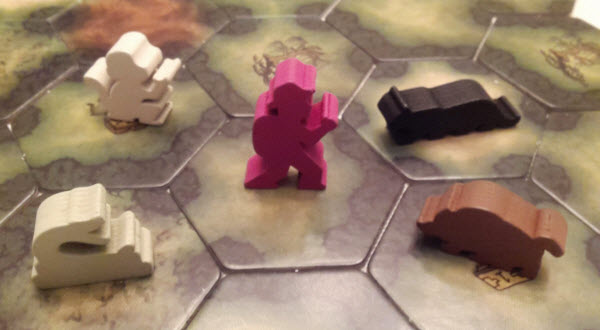14 May, 1948
Dear Dr. Kasif,
Congratulations! You have been selected to be part of the Academy of Discovery’s exploratory group, where you will be venturing deep into dense and remote jungle basin to further learn about the peoples who used to occupy that region. They have long since vanished as a group, but recent reports reveal that elements of their culture may yet persist in the form of buildings, trinkets, and rare artifacts. Your objective will be to secure those artifacts for study. However, you are not alone. Other organizations have also learned about these findings and are looking to attain these items for themselves. Regrettably, that will make your job all the more difficult, but we know you’re up for the challenge. Your plane departs on Monday. Good luck.
Sincerely,
Arthur Brody Winston
Chairman, Academy of Discovery
The Premise
Lost treasures have been unearthed in a remote region of the jungle, and the race is on to recover these valuable artifacts. Players must compete with each other, and against the danger-riddled jungle itself, to complete their quest and be the first out of the jungle.
The Rules
Relic Expedition is an uncommon tile-laying game in that it does not follow a set tile placement structure – its confines are limited only to the playing surface. Initial setup begins with just the base camp board, but space is required for the remaining tiles, feature boards, and Relic and Supply tokens. Relic tokens are used to win the game, while Supply tokens are items players use while journeying around.
At the start of the game, each player is placed on a Helicopter square and given a backpack tray. Then, for each empty hexagon side adjacent to a player’s location, starting tiled are randomly placed. (However, although players are intrepid adventurers, they do not start with any equipment.) Players roll to determine the starting player.
Turn structure in Relic Expedition is simple. First, the player rolls two dice: an Animal die, and an Action die. The Animal die is resolved first. It depicts one of four types of animals, being a Snake, Boar, Panther, or Monkey. Any animals on the board matching the die result move. Starting with the active player, each player moves one animal of that type up to two spaces. If it enters a tile with an player, an Encounter occurs.
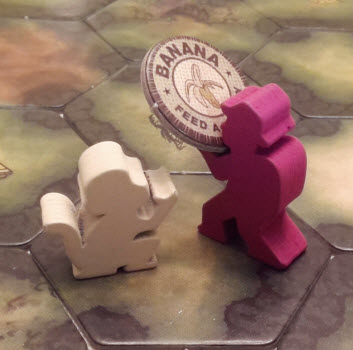
Monkey want Banana!
Encounters vary depending on the animal(s) involved and whether a player has the appropriate Supply item to handle them. If they do, the item is used up, and the animal is either removed, Tranquilized, or merely become Occupied.
Tranquilized and Occupied animals no longer threaten the player so long as they both remain on that tile, but they cannot move again until the player does. However, if the player does not have the appropriate Supply item, the animal inflicts its damage, which ranges from losing turns to losing some or all backpack items.
Once animal movement and Encounters have been resolved, the player then resolves their Action die. The die ranges from two to four and specifies the number of actions a player has that turn. Actions can be used in one of three ways:
- For one action, the player draws a Supply item and adds it to their backpack.
- For one action, the player moves to an adjacent tile with an open edge, or for two actions they move to an adjacent tile with a thick jungle edge.
- For three actions, the player may move from one Helicopter tile to another.
Players continue to move and or draw Supplies until they are out of actions. Then it becomes the next player’s turn.
When moving to a tile with an unexplored edge, new tiles are randomly placed. Tiles in Relic Expedition come with a number of different symbols on them. These symbols denote favorable spaces containing Relic tokens or Supply tokens like Bananas and Vines, or unfavorable spaces like Quicksand, Poison Ivy, and animals.
Items on a player’s tile may be picked up and dropped off without using an action. However, a player may never carry more than eight Supplies and/or Relics at any time.
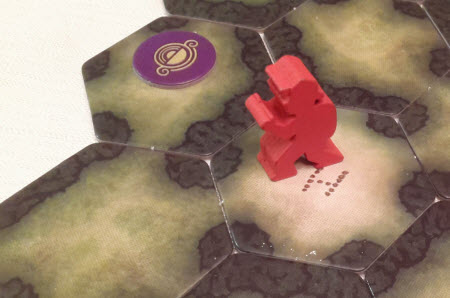
Red can spend two actions to move and grab the Relic, or one action to move to the empty space.
In addition to normal tiles, there are three special tiles corresponding to one of three Feature boards, being the River, Mountain, and Cave. These boards are added to the special tile’s location when revealed. That said, each board requires special Supply items to access. (For example, Climbing Gear is required to access the Mountain.) In exchange for this difficulty, Feature boards come with between four and six Relic tokens each. While a player may only remove half of them from that location, they provide guaranteed Relic locations.
The objective in Relic Expedition is to, well, collect Relic tokens. Relic tokens come in six different insignia and six different colors. In order to win, a player must collect either four Relics of the same insignia or four of the same color. Then, the player must get to a Helicopter tile and spend three actions to leave the jungle. The first player to disembark with their treasures in hand is the winner. They will be rewarded with a small fortune, and likely a spot of fame.
Everyone else gets…malaria?
Rough Terrain Ahead
Undoubtedly, the first thing that catches people’s attention with this game is its look. At first glance, Relic Expedition appears to some as unfinished, a veritable spread of green and brown hues strewn across its surfaces. They wouldn’t inherently be wrong. The artwork of the tiles can seem rather spartan and rudimentary, as if the game simply did what it could with a limited budget.
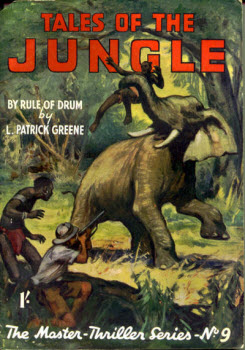 However, those versed in the theme’s source material can attest that the art style was chosen deliberately. From the tiles to the box cover itself, Relic Expedition’s artwork was crafted in the style of classic era adventure comics, replete with the subgenre’s often muted color schemes and 4CP “dots” style of the time period. Relic Expedition is itself an homage to those classic adventure stories, and the designers shrewdly use the art to convey the experience beyond simply racing off to find lost and forgotten treasures.
However, those versed in the theme’s source material can attest that the art style was chosen deliberately. From the tiles to the box cover itself, Relic Expedition’s artwork was crafted in the style of classic era adventure comics, replete with the subgenre’s often muted color schemes and 4CP “dots” style of the time period. Relic Expedition is itself an homage to those classic adventure stories, and the designers shrewdly use the art to convey the experience beyond simply racing off to find lost and forgotten treasures.
That said, this adherence is not without issue. The artwork largely works for the game, but in some instances Relic Expedition can get in its own way. There could have been a greater distinction between the green and brown-tinted Supply tokens, for example, as they look very similar on quick inspection, as do the shades of green between normal jungle tiles and Poison Ivy tiles. The animal markings on the tiles also could be slightly more prominent. Granted, these things don’t add complexity or detract substantially from the game’s overall value, but there are occasions during setup or throughout the course of the game that a double-take is sometimes necessary.
Chance Favors The Bold
Relic Expedition also stands out due to its unorthodox map expansion. Rather than have tiles expand in a formulaic or predictable manner, how the layout unfolds is largely up to the players themselves. If each person moves off in a different direction, for instance, the game can easily become a spiderweb of tile pathways. When you pair that with the randomness of the tiles, it guarantees that you’ll never have the same map twice. Will you be the one to first stumble across the Cave, or will you run into a Relic-free cove of unhappy animals? Do you even have the gear to even get in the Cave? These sort of scenarios are what makes Relic Expedition worthwhile.
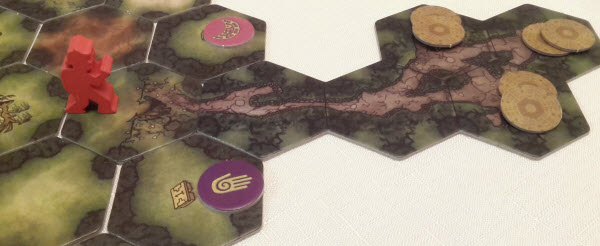
Red found the Cave, but he has no head lamp and is scared of the dark.
It also quickly becomes evident that there are elements of randomness across the entire breadth of the game, whether it’s which animals move, which Relics are discovered, or which Supplies are drawn. On the one hand, all of this randomness wonderfully encapsulates the game’s theme: you’re running through unknown and foreign terrain, and danger could literally be around any corner. How well your adventurer succeeds depends on whether they have the right tools at the right time, and you will pay the price if you don’t. Exploration is, after all, the only route to success. Relic Expedition makes flavorful use of these more chaotic aspects, and that’s difficult for most non-party games to do successfully. Between the artwork and the game’s play style, Relic Expedition handily succeeds on a thematic level and easily brings out the inner treasure seekers in Immersionists and Daredevils alike.
On the other hand, the game’s random nature makes it incredibly hard to plan around. This is decidedly not a game for Tacticians. Relic Expedition also falls short for Architects, which is surprising given much of the game revolves around exploring new territory and acquiring items for your backpack. They appreciate that the backpack mechanic is both an elegant and a useful tool to enhance decision-making, but Architects won’t enjoy having to sacrifice their useful items simply to make room for the game’s win condition. They’d rather just get a bigger backpack.
Similarly, Strikers will struggle with the degree of luck involved in Relic Expedition. The animals do provide a bit of player vs player combativeness – and they’ll enjoy using that to stymie competition – but whether that is enough to overcome the randomness factor will depend on the individual Striker.
Minor Provisions
Relic Expedition is capable of two to four players, but to get the best experience more players is better as it speeds up the time it takes explore all of the tiles while maximizing the use of animals attacking unprepared adventurers.
Moreover, its uncomplicated and intuitive nature should appeal to the gaming levity that Socializers enjoy. However, as straightforward as Relic Expedition is, some Socializers could be put off after a playthrough or two due to the game’s hour play time or the multitude of tiny rules interactions.
Admittedly, Relic Expedition is a beautifully simple game to learn, but it does have a fair share of “If X happens, do Y” situations that may need to be referenced the first few times through. It just may take more than a moment to check. The full rules – shaped like a pocket journal – provide the vast majority of answers to questions that creep up, but it isn’t always in the first place you check. It’s minor, but the rules layout is where Relic Expedition stumbles the most; they could use a little more organization and clarity in a few areas.
The Takeaway
Relic Expedition sets out to take you on a classic treasure-seeking adventure, and it certainly succeeds. In a number of ways, Relic Expedition embodies the same spirit of classic Ameritrash games like Risk or Monopoly: they are thematic, easy to learn, have high degrees of randomness, and are (perceived to be) family friendly, but they possess cutthroat mannerisms that sometimes make you question that assessment. This is not a jab at the game’s worthiness, however. In Relic Expedition, its unique blend of these ideas actually make for a rewarding, if unpredictable, experience.
The art may not resonate with everyone, and the rules could use a touch-up, but these facts are generally offset by the number of things the game does right. Relic Expedition’s strongest attribute is how the game’s simple mechanics and theme continually play off one another. The game never lets you forget that you are a jungle explorer and everything around you is out to get you. Your expeditions only last about an hour, but don’t be surprised if you’ll soon be ready for another Relic Expedition. After all, you simply can’t keep a good adventurer down for long. Even with a Panther.
Relic Expedition is a product of Foxtrot Games.
Cardboard Republic Snapshot Scoring (Based on scale of 5):
Artwork: 3
Rules Clarity: 3
Replay Value: 3.5
Physical Quality: 4.5
Overall Score: 4


